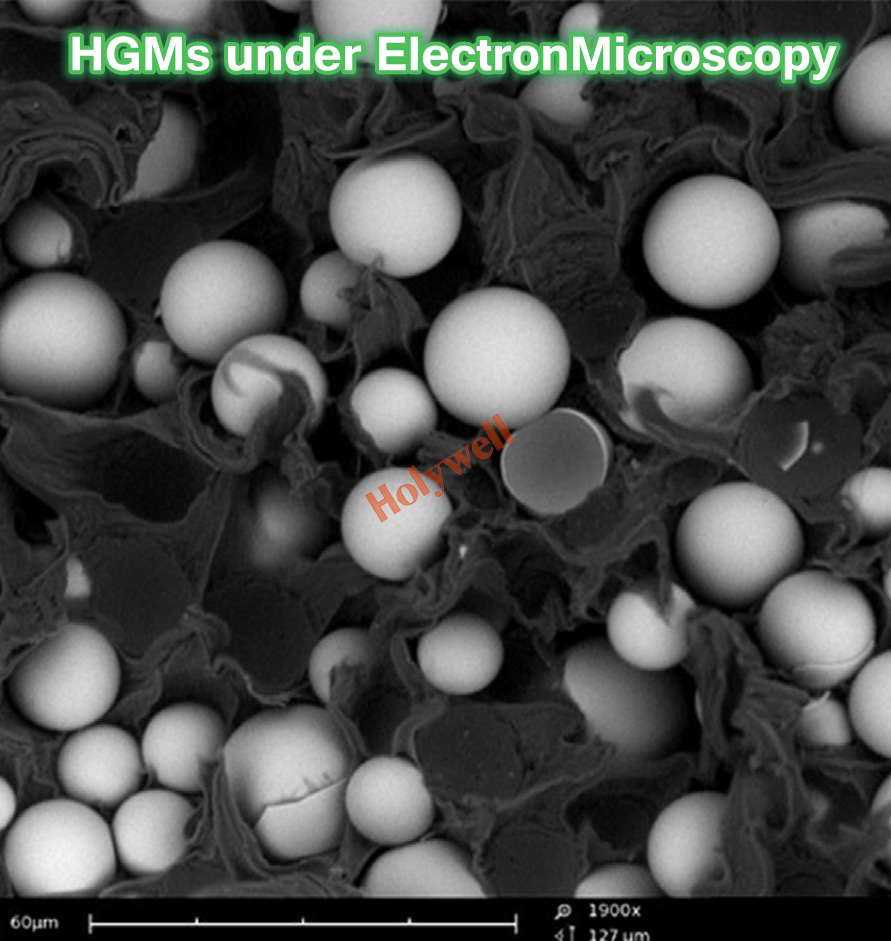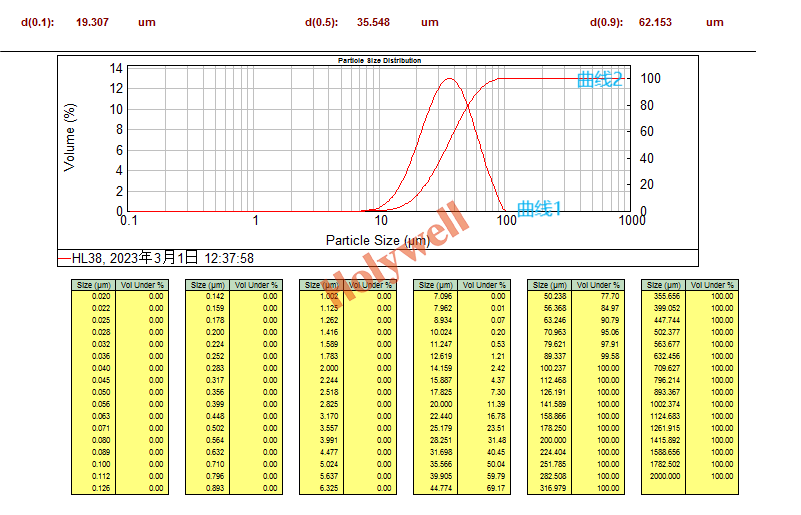TEL : +86 186 3817 6371
Email : info@cnholywell.com
TEL : +86 186 3817 6371
Email : info@cnholywell.com
Hollow Glass Microspheres (also known as Glass Bubbles) are micron-sized glass microspheres with a smooth surface and appear as white fluid powder. The physical parameters characterizing hollow glass microspheres mainly include density, particle size and distribution, compressive strength, etc. Known the meaning of each physical property parameter of hollow glass microspheres and the relationship between each physical property will help us better understand and use the product.
 Figure 1
Figure 1
Density refers to the mass per unit volume of a substance. In calculations, density is the quotient of mass divided by volume, that is, the ratio of mass to volume of a substance. True density, refers to the density of a substance after removing internal pores or gaps between particles. Hollow glass microspheres are closed spheres, and their true density is the density after removing the gaps between the microspheres. Packing density refers to the mass per unit volume of powder materials in a naturally stacked state. The bulk density is the mass of the powder divided by the volume of the container occupied by the powder. The density calculated based on natural packing volume is also called loose density, and the density calculated based on vibrated volume is called tap density. Since the volume of the container occupied by the powder (packing volume) includes the gaps between the powders, the packing density is usually less than the true density. The packing density of hollow glass microspheres is about half of the true density. Holywell uses a gas displacement method true density analyzer to measure the true density, which can quickly and accurately measure the true density of microspheres.
True density can guide our product applications and composite material formulation design, while bulk density has guiding significance for the packaging and transportation of powders. The true density of our hollow glass microspheres is 0.12-0.6g/c3, which is about 1/5-1/10 of traditional powder materials. For products of the same quality, hollow glass microspheres occupy less space than traditional powder materials. Much bigger. Adopting appropriate packaging methods can transport goods more economically and environmentally, while reducing the space occupied by goods in the warehouse.

Figure 2
Powder is a collection of small particles of different sizes. The size of the particles is called the particle size. Hollow glass microspheres are spherical particles, and the diameter of the sphere is the particle size. Particle size distribution refers to the percentage of particles of different sizes in the total amount of powder. It has two forms: interval distribution and cumulative distribution. Interval distribution, also known as differential distribution or frequency distribution, represents the percentage of particles in a series of particle size intervals. In Figure 2 below, curve (a) is the particle size interval distribution curve of Holywell hollow glass microspheres HL38. On this curve, the left ordinate value corresponding to the particle size value on the abscissa is not the percentage corresponding to the particle size. content, but the first derivative of particle percentage with respect to particle size. Cumulative distribution, also called integral distribution, represents the percentage of particles smaller than or equal to a certain particle size. In Figure 2 below, curve (b) is the cumulative distribution curve of HL38. The ordinate value on the right side is the cumulative percentage corresponding to the particle size on the abscissa, that is, the percentage of particles smaller than or equal to this particle size value, or Say, the percentage of particles below this particle size value.
In our COA reports, the cumulative distribution data of several typical particle sizes are D50 and D90.
D50 refers to the particle size corresponding to when the cumulative particle size distribution percentage of a sample reaches 50%. Particles smaller than it account for 50%, and particles larger than it also account for 50%. D50 is also called the median particle size.
D90 refers to the particle size corresponding to when the cumulative particle size distribution percentage of a sample reaches 90%, and 90% of the particles are smaller than it.
The particle size distribution of hollow glass microspheres is a percentage distribution based on the volume basis. The value corresponding to D90 we call represents the particle size value corresponding to when the cumulative particle size volume percentage reaches 90%. In other words, particles below this particle size account for 90% of the total volume. Sunlight uses a laser particle size analyzer to test the particle size distribution of hollow glass microspheres.
Compressive strength refers to the isostatic pressure corresponding to a certain value of the breakage rate of hollow glass microspheres. The breakage rate refers to the volume percentage of broken hollow glass microspheres in the total hollow glass microspheres under a certain isostatic pressure. Compressive strength represents the ability of hollow glass microspheres to withstand strong isostatic pressure. Products with high compressive strength can better maintain the hollow structure during application, have a low product breakage rate, and obtain ideal composite material properties during production and processing. Sunlight uses a compressive strength tester to test the compressive strength of products. The sample is placed in a high-pressure chamber and nitrogen gas is introduced for pressurization. The density of the sample before and after pressurization is tested, and the crushing is determined by calculating the change in sample volume before and after pressurization rate.
In the production and processing of composite materials, the adding method of hollow glass microspheres and the operating conditions of the equipment may affect the application effect of the hollow glass microspheres. We should debug the operating parameters of the equipment to reduce the breakage rate of the hollow glass microspheres to as low as possible. lowest.
There is a certain correlation between the density, particle size and compressive strength of hollow glass microspheres. The wall thickness of the microbeads has a certain influence on the parameters. Generally speaking, the larger the particle size, the larger the volume of the sphere, the smaller the density of the microbeads, and the lower the compressive strength; conversely, the smaller the particle size, the greater the density of the microbeads, and the higher the compressive strength. Therefore, generally, low-density products have larger particle sizes and lower strength; high-density products have smaller particle sizes and higher strength. Particle size distribution also has a certain impact on compressive strength. Generally, products with narrow particle size distribution have higher compressive strength and also enable better performance of composite materials.
The density, particle size and compressive strength of hollow glass microspheres are controlled by the production process. In practical applications, sometimes we need products with specific density and particle size, sometimes we need low-density products with small particle size and high strength. At the same time, , the development of composite material application technology has also put forward higher requirements for product performance. Sunlight will continue to conduct new product research and development and produce more high-performance products guided by market demand and customer satisfaction.